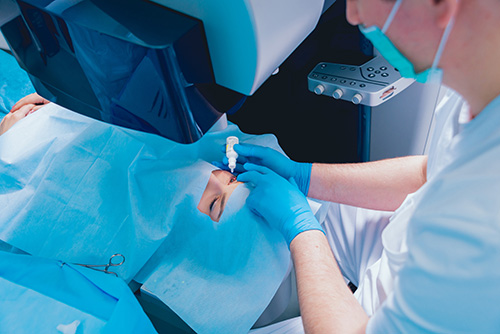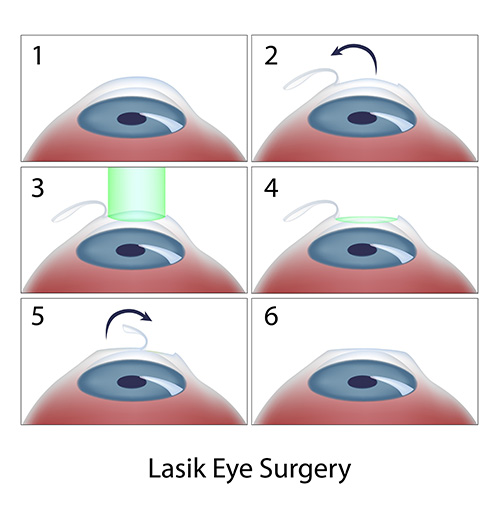LASIK Eye Surgery in Manhattan

LASIK is an acronym for Laser In-situ Keratomileusis, which simply means “to shape the cornea from within”. In LASIK, the Excimer laser is used to reshape tissue from the center of the cornea rather than its surface (as in Epi-Lasik). Either a laser or an instrument known as a microkeratome is used to raise a partial-thickness flap of corneal tissue. The flap is then lifted and the laser is applied. After 30-90 seconds of laser treatment, the flap is then replaced without the necessity for stitches.
The advantages of LASIK over Epi-LASIK in the scientific literature include:
- Less postoperative discomfort
- Quicker visual recovery
- Ability to have both eyes corrected within days
- Briefer necessity for drops (one week)
- Ability to correct higher levels of nearsightedness
However, LASIK is a technically more complex procedure to perform than Epi-Lasik, and it is generally up to the doctor’s experience and discretion whether they would prefer LASIK over Epi-Lasik. The choice can be discussed with the doctor in greater detail during your visit. In general, the higher the degree of myopia, the more likely LASIK is preferred.
What are the results and success rates of the Epi-Lasik and LASIK procedures?
The great majority of patients in our practice are glasses-free after LASIK and obtain 20/20 vision. Your individual likelihood of achieving 20/20 will be discussed with you during your free consultation. In general, the lower the correction level, the higher the change of achieving 20/20 with a single treatment. Overall, less than 5% of patients require a second treatment to achieve 20/20. It is our practice’s mission to help our patients be very happy with their outcome and minimizing risk. For a more detailed insight of results, please see the attached handbook.
Why do so many patients choose to have LASIK eye surgery here?
Dr. Ken Moadel has been specializing in LASIK surgery for over 20 years and has performed over 100,000 procedures. Patients have traveled from Europe, South America and as far as Japan just for his expert care and experience. Dr. Moadel is committed to providing quality patient care and accordingly, a high percentage of patients are found not suitable candidates.
In General:
- LASIK is one of the most sought after procedures for moderate & high nearsightedness (over-4D)
- Patients who require the rapid return of vision prefer LASIK
Schedule Your Free Consultation Today!
The Cost of LASIK Eye Surgery in Manhattan
Compared to wearing glasses and contact lenses for over 5-10 years LASIK is actually a great value. We are dedicated to providing affordable, quality eye care and offer special payment plans to fit most budgets. Our LASIK Coordinator will be happy to discuss these financing options and what this will cost on a monthly basis. Enrollment is often very easy!
Payment Options
We have a variety of payment options designed to make this decision more of a reality for all of our prospective patients.

CareCredit – LASIK eye surgery financing Care Credit has very easy to use healthcare financing. You can contact care credit with one of our LASIK coordinators or you can call them directly at 800.859.9975.
Credit Cards Accepted
- VISA
- MasterCard
- American Express
- Discover
Expert LASIK Surgeon
Dr. Moadel is a New York City LASIK surgeon and LASIK vision correction expert with New York LASIK centers midtown Manhattan. If you are seeking LASIK in Manhattan please feel free to contact Dr. Moadel today to learn more about LASIK eye surgery and the experience of the staff and physician.
Disclaimer: The intent of this website is to educate users about eye care. Information found on this website is not intended to replace medical advice. Questions about treatment information should be addressed by your physician.

“Make sure you see the best. Make sure you see Dr. Ken Moadel.”
– Bernie Williams
New York Yankees Star Centerfielder
The LASIK Procedure – From a Patient’s Perspective

Upon arriving at the office, patients receive a small dose of a relaxant pill. An hour or so is spent measuring the eyes before the procedure. Upon entering the laser suite, the patient reclines in the laser chair. Anesthetics and antibiotic drops are instilled. There is no intravenous or need for general anesthesia (need to be put to sleep).
Under the laser, the patient is asked to concentrate on a red blinking light. A retainer is then placed to assist in keeping the eye open. During the actual procedure, the patient feels pressure and the red light is lost for less than a minute.
The patient is asked to stare at the blinking red light again once it returns. As the laser fires, a ticking sound is heard that lasts 10-90 seconds.
After the laser is completed, the retainer is removed, and the patient is asked to sit up. Upon sitting, there is some improvement in vision noted.
The patient is asked to return home and get plenty of rest for several hours following the procedure. The following morning there is a substantial improvement in vision. However, the vision continues to incrementally improve for weeks.
LASIK Postoperative Care
Immediately after LASIK surgery, your vision will still be a little blurry but already improved. The morning after LASIK, you will see a significant improvement in your vision. A postoperative checkup is generally scheduled 1-day post-surgery, where you are advised not to wear makeup and avoid getting any foreign objects in your eyes. Drops are used several times daily for 1-3 weeks following the procedure. You will have several exams to assess the healing and progress over the next several months.
One of the most frequently asked questions regarding post-op LASIK is, “how quickly can I get back to work after LASIK?,” and the answer is often surprising: most people are back to their regular routine within a day or two of having had their LASIK procedure complete. Recovery time is minimal and Dr. Moadel will ensure that your LASIK recovery process is as brief and least inconvenient as possible.
Do patients see results from LASIK immediately?
Time to visual improvement depends on which procedure you have. LASIK patients generally experience a large improvement in vision within one day, followed by subtle improvements over a period of several weeks. Epi-LASIK patients, in general, will improve gradually over a one week period followed by progressive improvement over a period of several weeks.
During LASIK, are both eyes performed at the same time?
Our recommendation to patients is to perform one eye at a time when the prescription level is high. Performing one eye at a time increases safety and improves chances for better vision. Studies have indicated that second eyes have a higher chance of achieving 20/20 vision when the result from the first eye is determined. For this reason, our rate of enhancement (“touch-up”) is less than 5%, among the lowest in the field.
In terms of safety, performing one eye at a time minimizes risk, allowing the doctor and patient to assess the outcome of the first eye before going on to the second.
For patients where convenience is important and whose prescriptions fall within an acceptable range, we will consider performing both eyes at the same time.
When can I go back to work after LASIK and how often do I need to be seen?
Patients can usually return to work within a day or two. Typically they will need to be seen the day following the procedure, followed by visits at one week, one month, three months, and six months after vision correction. Most patients prefer to have their first eye performed on a Friday so that they can have the weekend to relax.
Is LASIK painful?
The procedure is generally painless or associated with little discomfort. Only anesthetic drops are used with no injections or needles. LASIK patients will generally have irritation for several hours after the procedure and feel no discomfort the day following the procedure. Epi-LASIK patients will feel irritation for 48-72 hours following the procedure until the protective contact lens is removed.
Who can not have LASIK performed?
Certain eye disorders and medical conditions including pregnancy are contraindications to Epi-Lasik and LASIK. Nursing mothers and patients with a history of uncontrollable autoimmune diseases should not have the procedure performed. Controlled hypertension and diabetes are usually not contraindications.
What is the risk of complications following LASIK eye surgery?
Like all medical procedures, LASIK eye surgery has inherent risks. The main concern of most patients is the loss of best vision, which is extremely rare. Our practice’s conservative nature has limited risks for over two decades and is the reason other doctors have continued to refer their patients for excellent, thoughtful care.
The primary risk of all laser vision correction relates to the subjective parameters in vision including changes in sharpness, clarity, distortions around headlights at night, and dryness. The tendency for these parameters to worsen varies from person to person. The risk may be low for some and higher for others. Your individual tendency to develop side effects can be assessed during your free consultation. A more detailed assessment of risk can be viewed in the attached handbook in the results section.
How long does the LASIK procedure take?
LASIK Eye Surgery takes between 5 to 10 minutes and patients return home within several hours. Actual exposure to the laser is only seconds.
What is the rate of patient satisfaction with LASIK?
Our practice has benefited from a very high degree of patient satisfaction. Over 98% of our patients expressed satisfaction with their LASIK results and would have the procedure performed again. 98% of our patients would recommend our services to a family member or friend.
Are hyperopia (farsightedness) and presbyopia also corrected with LASIK?
Hyperopia correction has been approved by the FDA. However, presbyopia – the inability to read close, small objects (such as newspaper print) that occur over the age of 40, cannot be corrected with the laser.
How long has the technology been available and how many procedures have been performed?
Excimer laser technology has been commercially available since the late 1980s in Europe, South America, and Asia. Over three million procedures have been performed since that time. The US FDA was one of the final governing bodies to approve its application in October 1995. Since that time millions of procedures have been performed in the US alone.
Is There Financing Available For LASIK Eye Surgery?
Yes, we have made an alliance with AmeriFee for The Vision Fee Plan. Check out our”How Do I Get Financing?” section for more details.
Take Our LASIK Self-Test Today!
Want to learn more about LASIK?
Can I afford to have LASIK?
The Most Common LASIK FAQ’s
Am I a Candidate for LASIK?
What to Expect at a LASIK Consultation
The Ultimate Guide to LASIK in NYC




